实验3:OpenFlow协议分析实践
实验3:OpenFlow协议分析实践
第一部分:基本实验
实验步骤1
-
搭建下图所示拓扑,完成相关 IP 配置,并实现主机与主机之间的 IP 通信。用抓包软件获取控制器与交换机之间的通信数据包。
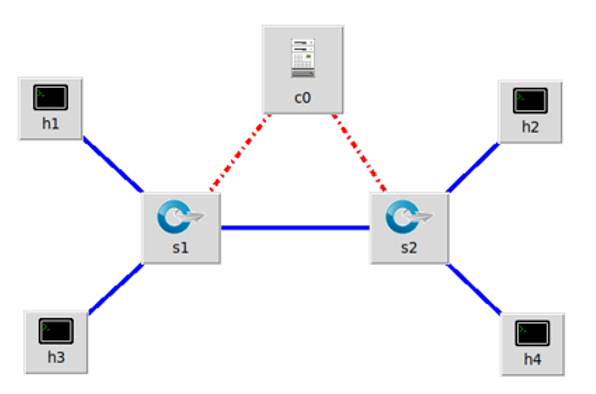
主机 IP地址
h1 192.168.0.101/24
h2 192.168.0.102/24
h3 192.168.0.103/24
h4 192.168.0.104/24 -
导出的拓扑文件

实验步骤2
-
查看抓包结果,分析OpenFlow协议中交换机与控制器的消息交互过程,画出相关交互图或流程图。
-
控制器(端口6633)与交换机(端口41424)相互交换hello报文建立连接,并使用OpenFlow 1.0
-
控制器向交换机发送hello报文
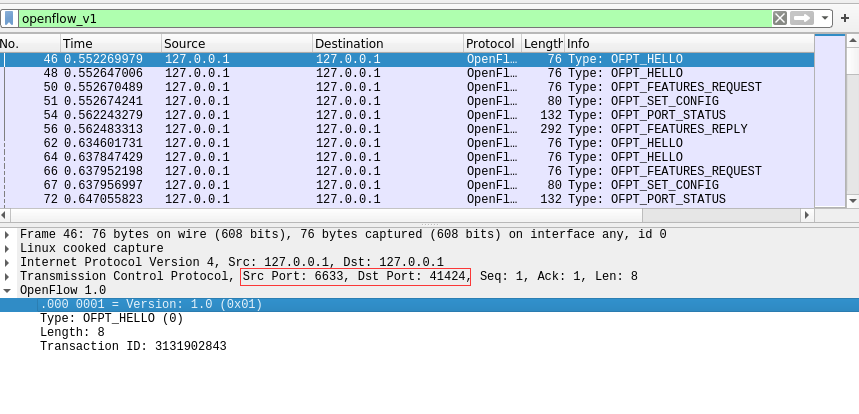
-
交换机向控制器发送hello报文

-
控制器(端口6633)向交换机(端口41424)发送Features Request报文,请求获取交换机的特征信息
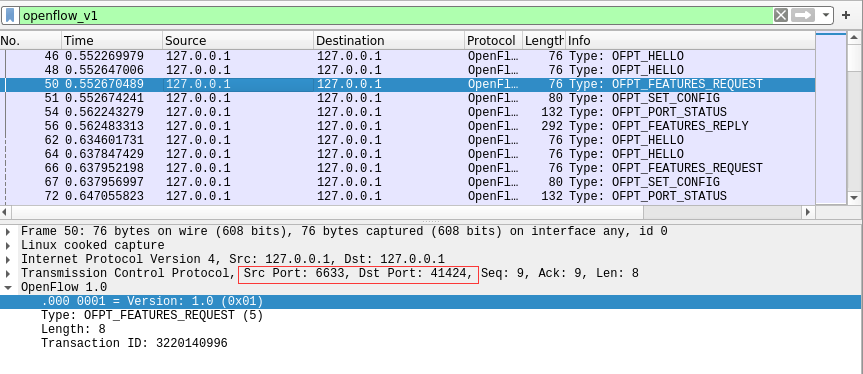
-
控制器(端口6633)向交换机(端口41424)发送Set Config报文,要求交换机按照指定的flag和max bytes of packet进行配置

-
当交换机端口发生变化时,发送Port_Status报文告知控制器相应的端口状态
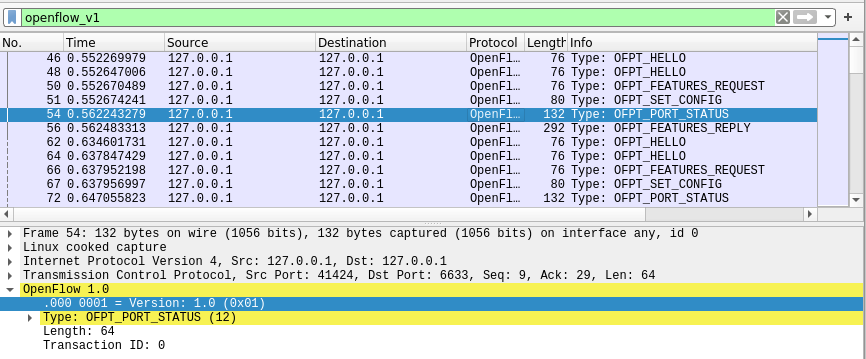
-
交换机(端口41424)向控制器(端口6633)回送Features Reply报文,通知控制器查收自己的特征信息
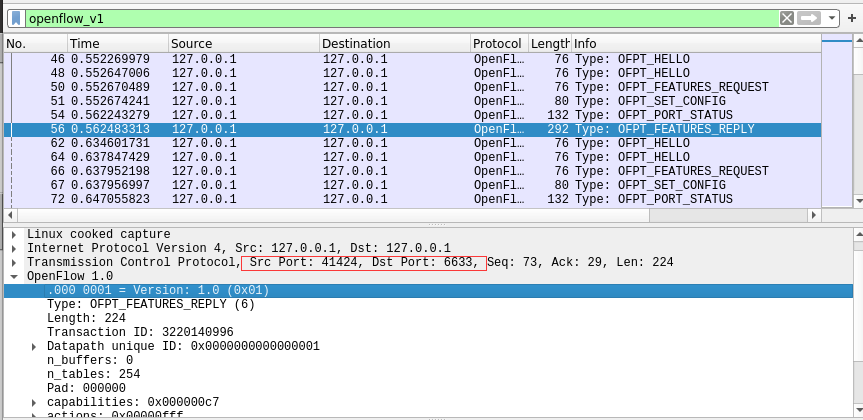
-
当交换机(端口41424)查找流表,发现没有匹配条目或者有匹配条目但是对应的action是OUTPUT=CONTROLLER时
-
向控制器(端口6633)发送Packet_in报文,询问控制器要如何处理
下述截图交换机发送Packet_in报文的原因是查找流表时候没有发现匹配条目
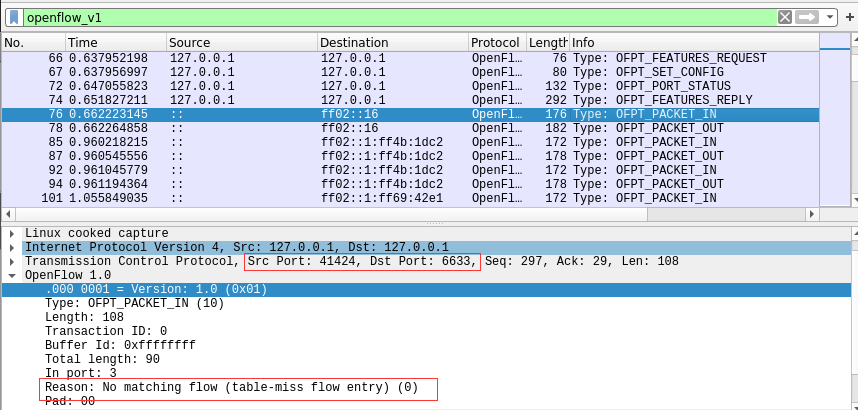
交换机由于有匹配条目但是对应的action是OUTPUT=CONTROLLER而发送Packet_in报文的情况在抓包时候没有找到 -
控制器(端口6633)收到Packet_in报文后回送给交换机(端口41424)Packet_out报文,指示它按照自己得action进行处理

-
由于stop capturing packets过快,未能通过pingall测试抓取到flow_mod数据包,因此再重新进行一次capturing packets
-
控制器(端口6633)向交换机(端口41562)发送Flow_mod报文,指导数据的转发处理
-
mininet命令行输入pingall
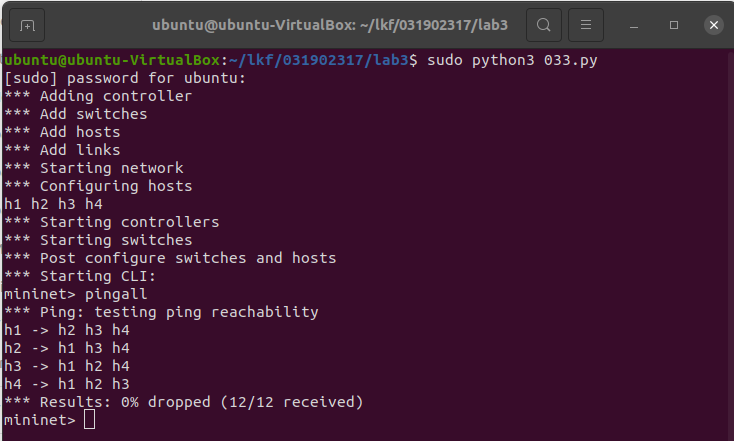
-
抓取flow_mod数据包
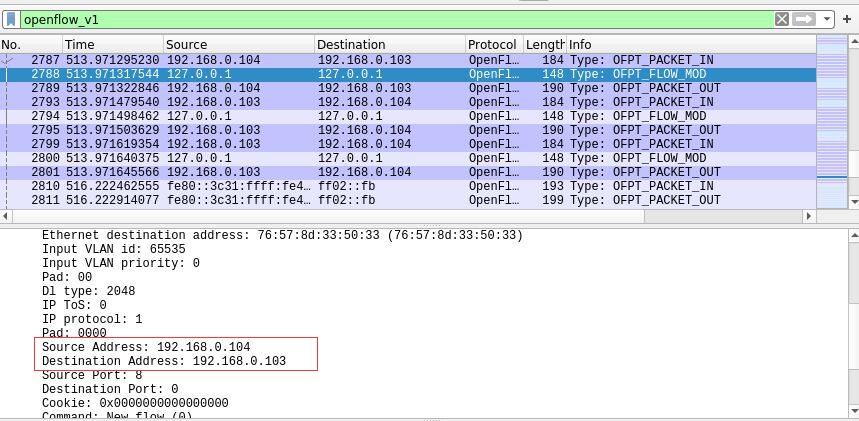
-
交互图

实验步骤3
- 交换机与控制器建立通信时是使用TCP协议还是UDP协议?
使用TCP协议,通过抓包可知
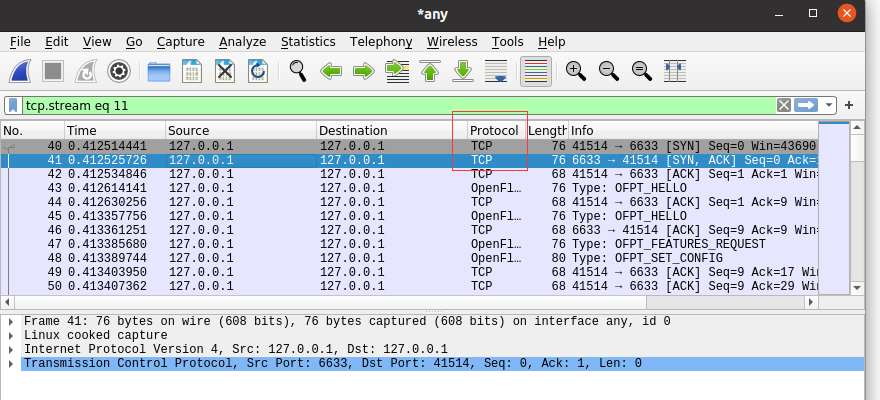
第二部分:进阶实验
实验要求
将抓包结果对照OpenFlow源码,了解OpenFlow主要消息类型对应的数据结构定义。
- 相关数据结构可在openflow安装目录openflow/include/openflow当中的openflow.h头文件中查询到。
hello数据包
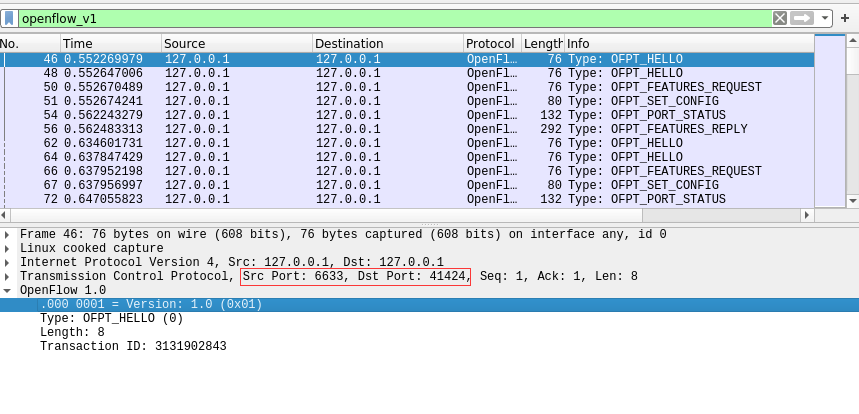
struct ofp_header {
uint8_t version; /* OFP_VERSION. */
uint8_t type; /* One of the OFPT_ constants. */
uint16_t length; /* Length including this ofp_header. */
uint32_t xid; /* Transaction id associated with this packet.
Replies use the same id as was in the request
to facilitate pairing. */
};
struct ofp_hello {
struct ofp_header header;
};
Features Request数据包
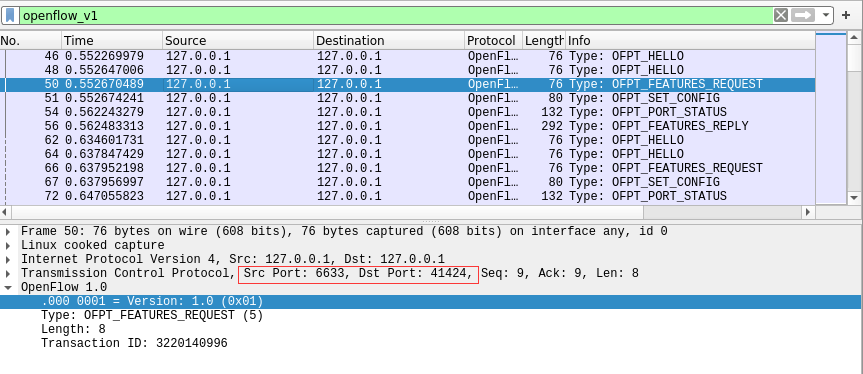
struct ofp_header {
uint8_t version; /* OFP_VERSION. */
uint8_t type; /* One of the OFPT_ constants. */
uint16_t length; /* Length including this ofp_header. */
uint32_t xid; /* Transaction id associated with this packet.
Replies use the same id as was in the request
to facilitate pairing. */
};
struct ofp_hello {
struct ofp_header header;
};
Set Config数据包
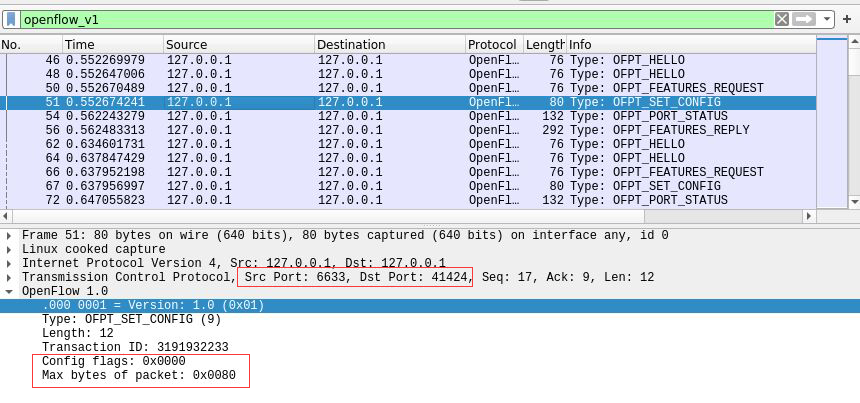
/* Switch configuration. */
struct ofp_switch_config {
struct ofp_header header;
uint16_t flags; /* OFPC_* flags. */
uint16_t miss_send_len; /* Max bytes of new flow that datapath should
send to the controller. */
};
Port_Status数据包

/* A physical port has changed in the datapath */
struct ofp_port_status {
struct ofp_header header;
uint8_t reason; /* One of OFPPR_*. */
uint8_t pad[7]; /* Align to 64-bits. */
struct ofp_phy_port desc;
};
Features Reply数据包
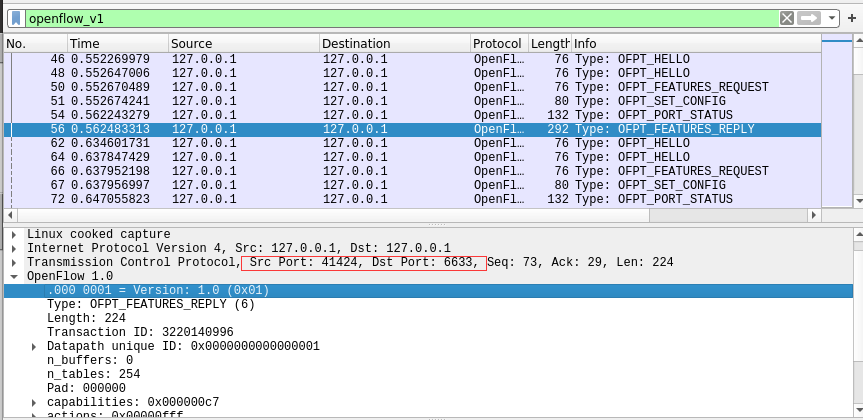
struct ofp_switch_features {
struct ofp_header header;
uint64_t datapath_id; /* Datapath unique ID. The lower 48-bits are for
a MAC address, while the upper 16-bits are
implementer-defined. */
uint32_t n_buffers; /* Max packets buffered at once. */
uint8_t n_tables; /* Number of tables supported by datapath. */
uint8_t pad[3]; /* Align to 64-bits. */
/* Features. */
uint32_t capabilities; /* Bitmap of support "ofp_capabilities". */
uint32_t actions; /* Bitmap of supported "ofp_action_type"s. */
/* Port info.*/
struct ofp_phy_port ports[0]; /* Port definitions. The number of ports
is inferred from the length field in
the header. */
};
/* Description of a physical port */
struct ofp_phy_port {
uint16_t port_no;
uint8_t hw_addr[OFP_ETH_ALEN];
char name[OFP_MAX_PORT_NAME_LEN]; /* Null-terminated */
uint32_t config; /* Bitmap of OFPPC_* flags. */
uint32_t state; /* Bitmap of OFPPS_* flags. */
/* Bitmaps of OFPPF_* that describe features. All bits zeroed if
* unsupported or unavailable. */
uint32_t curr; /* Current features. */
uint32_t advertised; /* Features being advertised by the port. */
uint32_t supported; /* Features supported by the port. */
uint32_t peer; /* Features advertised by peer. */
};
Packet_in数据包
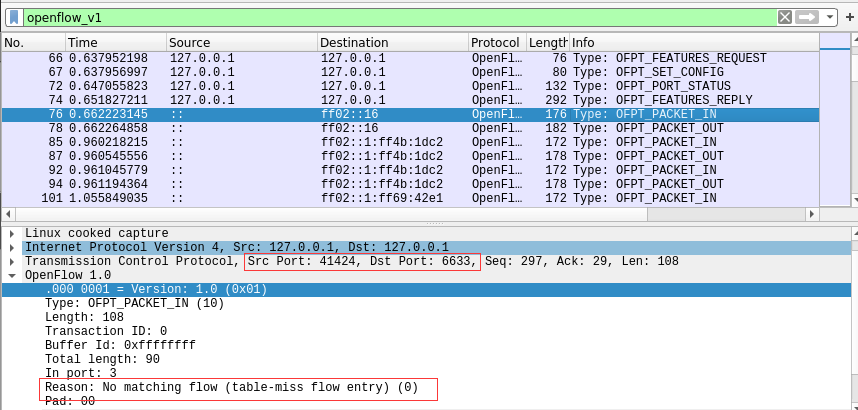
enum ofp_packet_in_reason {
OFPR_NO_MATCH, /* No matching flow. */
OFPR_ACTION /* Action explicitly output to controller. */
};
struct ofp_packet_in {
struct ofp_header header;
uint32_t buffer_id; /* ID assigned by datapath. */
uint16_t total_len; /* Full length of frame. */
uint16_t in_port; /* Port on which frame was received. */
uint8_t reason; /* Reason packet is being sent (one of OFPR_*) */
uint8_t pad;
uint8_t data[0]; /* Ethernet frame, halfway through 32-bit word,
so the IP header is 32-bit aligned. The
amount of data is inferred from the length
field in the header. Because of padding,
offsetof(struct ofp_packet_in, data) ==
sizeof(struct ofp_packet_in) - 2. */
};
Packet_out数据包

struct ofp_packet_out {
struct ofp_header header;
uint32_t buffer_id; /* ID assigned by datapath (-1 if none). */
uint16_t in_port; /* Packet's input port (OFPP_NONE if none). */
uint16_t actions_len; /* Size of action array in bytes. */
struct ofp_action_header actions[0]; /* Actions. */
/* uint8_t data[0]; */ /* Packet data. The length is inferred
from the length field in the header.
(Only meaningful if buffer_id == -1.) */
};
Flow_mod数据包
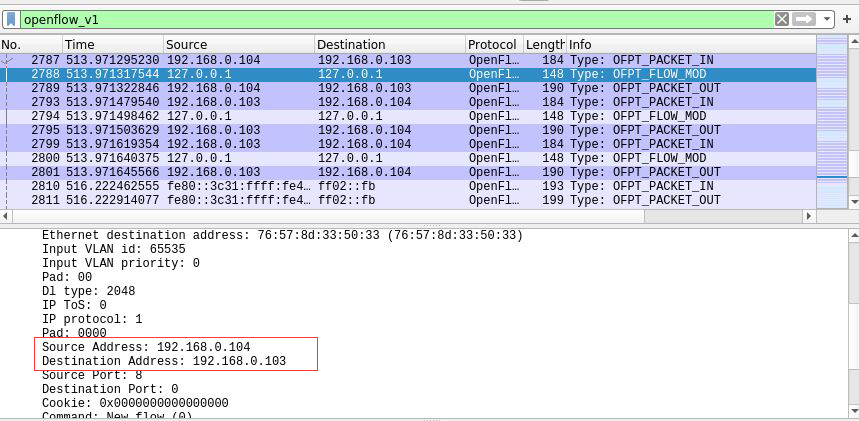
struct ofp_flow_mod {
struct ofp_header header;
struct ofp_match match; /* Fields to match */
uint64_t cookie; /* Opaque controller-issued identifier. */
/* Flow actions. */
uint16_t command; /* One of OFPFC_*. */
uint16_t idle_timeout; /* Idle time before discarding (seconds). */
uint16_t hard_timeout; /* Max time before discarding (seconds). */
uint16_t priority; /* Priority level of flow entry. */
uint32_t buffer_id; /* Buffered packet to apply to (or -1).
Not meaningful for OFPFC_DELETE*. */
uint16_t out_port; /* For OFPFC_DELETE* commands, require
matching entries to include this as an
output port. A value of OFPP_NONE
indicates no restriction. */
uint16_t flags; /* One of OFPFF_*. */
struct ofp_action_header actions[0]; /* The action length is inferred
from the length field in the
header. */
};
struct ofp_action_header {
uint16_t type; /* One of OFPAT_*. */
uint16_t len; /* Length of action, including this
header. This is the length of action,
including any padding to make it
64-bit aligned. */
uint8_t pad[4];
};
第三部分:反思与总结
实验难度:
- 适中
实验过程遇到的困难及解决方法
- 首先是在抓包时候,前面一直发现自己没能抓到hello数据包,后面细看了pdf才发现要先打开wireshark软件
再运行拓扑文件,不然在wireshark的capture packets中会遗漏前面的数据包。接着就是由于自己为先提前
细看pdf需要抓取的包(Flow_mod),在实验中关闭抓包过程过早,导致重新开启下一轮抓包,出现了实验报告中
前面的交换机端口号与后面不匹配的情况。因此下次我要认真阅读完需要实验的内容再开始做,防止今天的错误
再次发生。最后就是在进阶实验中对源码的搜寻有点艰难,看着一段段代码,眼睛迷迷糊糊,好在能通过wireshark
内的数据包格式来对应。
个人感想
- 通过这次实验,通过多次地抓包对wireshark的抓包的过程、过滤器的使用以及抓包的作用有了更加清楚的认识,相信
自己后面能够灵活运用这次实验学到的新知识点。并且对openflow的交互流程有了更加深刻的认识,通过自己的不断抓包
对每一个流程会产生什么类型的包,以及包的作用有了理解性地掌握。懂得了如何运用openflow.h文件的源码来认识
抓到包的主要类型和数据结构。

